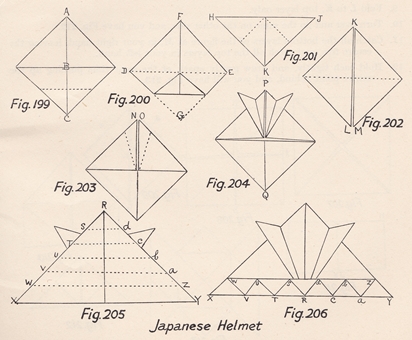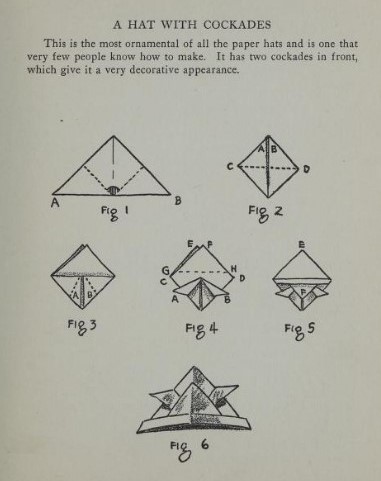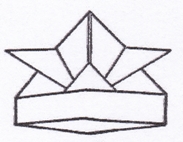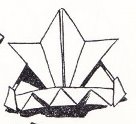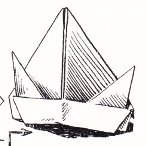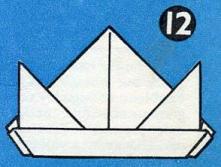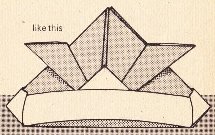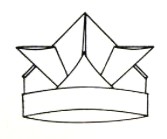| The Public Paperfolding History Project
Last updated 26/2/2024 x |
|||||||
| The Kabuto or Japanese Helmet or Samurai Helmet | |||||||
| This
page is being used to collect information about the
history of the paperfolding design known as the Kabuto,
Japanese Helmet or Samurai Helmet and it's animal face
variations. Please contact me if you know any of this
information is incorrect or if you have any other
information that should be added. Thank you. There are separate pages for the Nagakabuto and the Cut Goldfish variants of this design. ********** In China (and in publications by Chinese authors) 1914 Diagrams for this design, titled 'Pocket', appear in 'Zhe zhi tu shuo' (Illustrated Paperfolding), compiled by Gui Shaolie, which was published by the Commercial Press in Shanghai in Ming guo 3 (1914).
********** In Japan (and in publications by Japanese authors) 1804-1829 A print by Eishin Kikugawa (1787 - 1867) showing children playing various games includes two children, a boy and a girl, folding paper. The items threy have already folded are a Paper Crane, an unidentifiable box, a Paper Boat and what looks like a more complex version of the Kabuto or Samurai Helmet.
********** 1845 There is a note in the 'Kan No Mado', usually dated to 1845, which lists a helmet among those designs which are already well known and which are therefore not included in the ms (in order to spare the writer's brush). Unfortunately, lacking an illustration, we cannot know which design this note refers to. ********** c1854 This print by Utagawa Kuniyoshi, dated c1854, shows a woman holding a Kabuto out of reach of her child.
********** 1878 The Kabuto is pictured in 'Yochien Ombutsu No Zu', a publication of kindergarten material issued by the Tokyo Women's Normal School in 1878.
********** 1885 A drawing of the Kabuto appeared in 'Kindergarten Shoho' (Preliminary Kindergarten) by Iijima Hanjuro, which was copyrighted on October 4th Meiji 17 (1884) and published by Fukuda Senzo in August of Meiji 18 (1885).
********** 1893 Diagrams for the Kabuto appear in 1893 in volume 5 issue 16 of 'Shokokumin' children's magazine.
********** c1896/7 Print by Miyagawa Shuntei from the series Kodomo Fuzoku (Children's Customs and Manners) showing children folding a Paper Crane and a Kabuto.
********** 1903 Diagrams for the Kabuto appear in 'Jinjo Kouto Shogaku Shuko Seisakuzu' (Handicrafts for ordinary higher elementary schools) by Hideyoshi Okayama, which was published by Rokushiro Uehara in Tokyo in 1903.
********** A crease pattern (but no illustration of the finished design) appears under the title 'helmet' in 'Shukouka no Liron Oyobi Jissai' (Handicraft Theory and Practice) by Kuniho Nakamura and Shinpei Ito, which was published by Kofukan in Tokyo in 1903.
********** Diagrams also appear: 1904 In 'Shukouka Kyoju Shishin: Maiji Haitou' by Hyojiro Nakagaki, which was published by Kenseikai in Tokyo in 1904.
********** 1905 In 'Shukouka Kyohon : Liron Jishuu Souga Setsumei' by Kikujiro Kiuchi, Rokushiro Uehara and Hideyoshi Okayama, which was published by Shigebei Takase in Chiba in 1905.
********** 1907 In 'Shukou Tebikigusa : Kokumin Kyoiku Origami Yuihimo' by Ishin Nishigaki, which was published by Meguro Shoten in Nagaoka in 1907.
********** 1908 In 'Origami zusetsu' (Illustrated Origami) by Sano Shozo, which was published in Tokyo in 1908.
********** 1912 A drawing of the Kabuto appears in a monozukushi-e print, by an unknown artist, but said to be from the Meiji era. I have temporarily assigned it the date of 1912, the last year of that era, pending the discovery of more accurate information.
********** 1927 A drawing of a version of the Kabuto appears in an illustration by Takei Takeo in a 1927 issue of the children's magazine 'Kodomo No Kuni' (The Land of Children).
********** 1931 Diagrams for the Kabuto also appear in 'Origami (Part 1)' by Isao Honda, which was published in Japan in 1931
********** 1935 'Origami Moyo, Book One', by Kawarazaki Kodo, which was published by Unsodo in Japan in 1935, contained a print showing two Kabutos.
********** 1957 The Kabuto appears, as 'Helmet', in 'Origami: Book One' by Florence Sakade, which was published by the Charles E Tuttle Company in Rutland, Vermont and Tokyo in 1957.
********** 1958 A very simple rabbit face variation appears in 'Origami: Book Two' by Florence Sakade, which was published by the Charles E Tuttle Company in Rutland, Vermont and Tokyo in 1958
********** 1965 Diagrams for the Kabuto, under the name 'The Japanese Helmet' and for two decorative variants, the 'Rabbit Hat and 'Badger Hat' appear in 'The World of Origami' by Isao Honda, which was published in the USA by Japan Publications Trading Company in 1965.
********** 1968 A rabbit hat variation, titled 'Bunny B' appears in 'Origami in the Classroom: Book 2: Activities for winter through summer' by Chiyo Araki was published by Charles E Tuttle Co Inc in 1968
********** In Europe and the Americas 1889 'La Nature' of 28th September 1889 contained an article headed 'Recreation Scientifiques' and subheaded 'La Grenouille Japonaise en Papier' (The Japanese Paper Frog) which mentions the Paris Exposition of 1889 and states (here in translation) 'We also noticed in the exhibition other designs among which were the crab from red paper, the junk and the hat of Daimios (demon), the parrot etc.,' It is possible, although lacking an illustration hardly definite, that the hat of Daimios referred to here was the Kabuto. *********** 1900 A version of the Kabuto called 'La Coiffure aux plumes de paon' (The hat with peacock feathers) appears in an article in the French children's magazine 'Mon Journal', probably in 1900, although I have not been able to identify the exact date of the article.
********** 1908 The same diagrams appear in 'Les Petits Secrets Amusants' by Alber-Graves, which was published by Librairie Hachette in Paris in 1908.
********** Versions of the design also appear: 1922 In 'Houdini's Paper Magic', published by E P Dutton and Company of New York in 1922, which contains diagrams for a design called 'The Chapeau'. This design is the same as the normal Kabuto except that the horns, here called 'cockades' are folded at a lower position. The Chapeau is said to be of Japanese origin.
********** 1923 As the 'Improved Soldier's Hat' in 'More Paper Magic' by Will Blyth, which was published by C Arthur Pearson in London in 1923.
********** 1928 In an article titled 'Tricks and Twists with Paper', written by Sam Brown, in the February 1928 issue of Popular Mechanics magazine (with the cockades folded in a high position).
********** 1937 As the 'Japanese Helmet' in 'Paper Toy Making' by Margaret Campbell, which was first published by Sir Isaac Pitman and Sons Ltd in London, probably in 1937, although both the Foreword and Preface are dated 1936, which argues that the book was complete at that date.
********** 1939 As 'A Hat with Cockades' in 'Fun with Paper' by Joseph Leeming, which was published by Spencer Press Inc in Chicago in 1939.
********** 1948 As the 'Chinese Knight's Helmet' in 'The Art of Chinese Paper folding for Young and Old' by Maying Soong, which was published by Harcourt Brace and Company of New York in 1948'
********** 1956 Two versions of the Kabuto appear in 'Paper Magic' by Robert Harbin, which was published by Oldbourne in London in 1956, first as 'The Martian Helmet', although the text also says: 'Origin: Japanese Fighting Man's Helmet' ...
... and then as simply 'Another Hat'
********** 1959 The 1959 Rupert Annual contained instructions for folding the 'Another Hat' version of the Kabuto under the title of 'Rupert's Paper Cap'.
********** 1968 This version of the Kabuto, which has the outside corners turned up, appeared as the 'Samurai Hat' in 'Teach Yourself Origami: The Art of Paperfolding' by Robert Harbin, which was published by The English Universities Press in 1968.
********** 1968 The design also appeared, as the 'Chinese Knight's Helmet', in 'Your Book of Paperfolding' by Vanessa and Eric de Maré, which was published by Faber and Faber in London in 1968.
********** |
|||||||
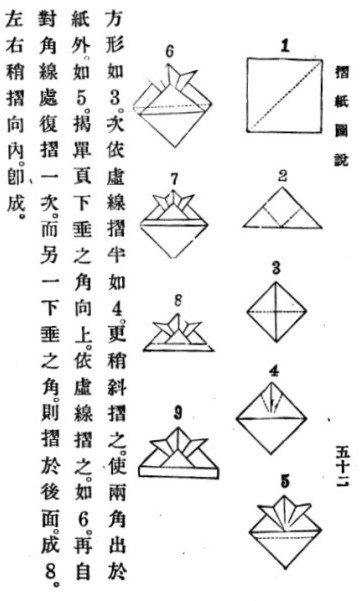
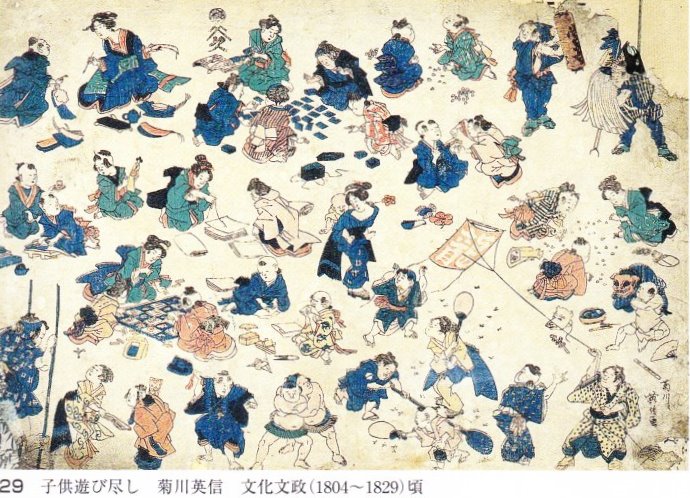
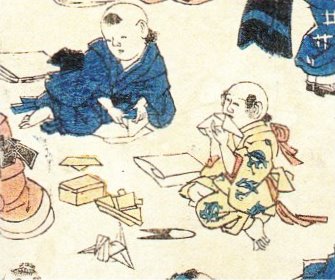
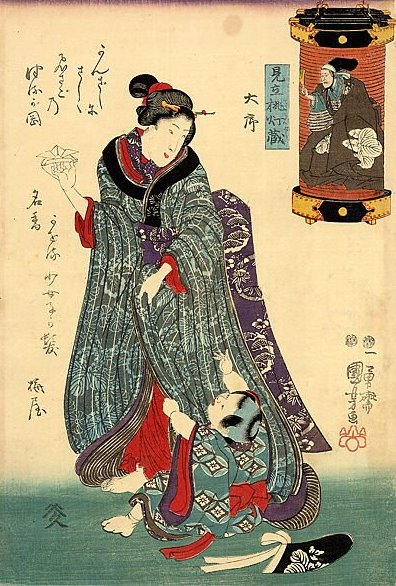
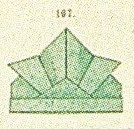
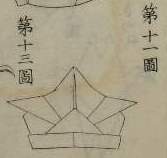
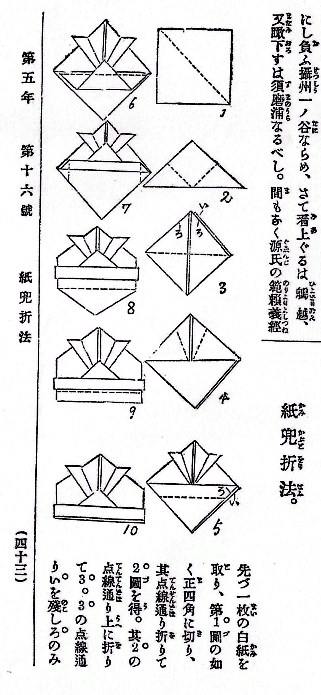
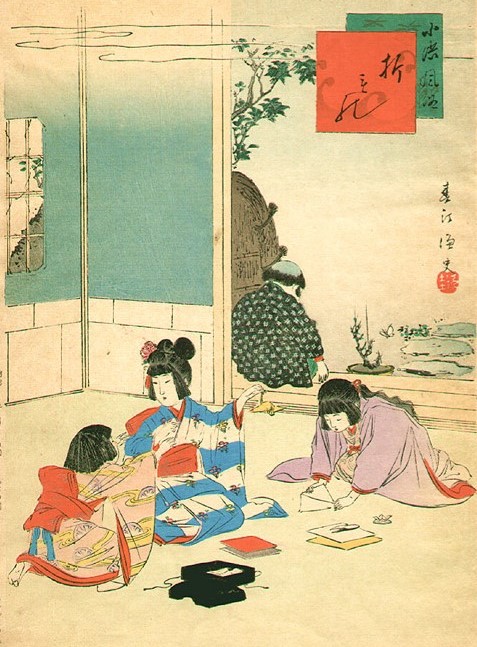
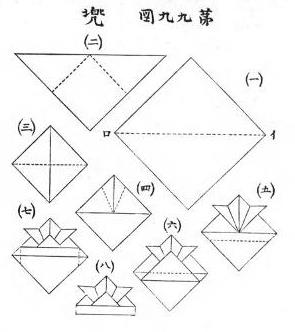

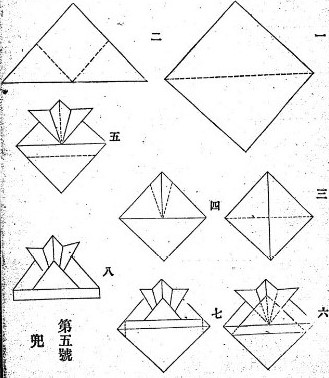
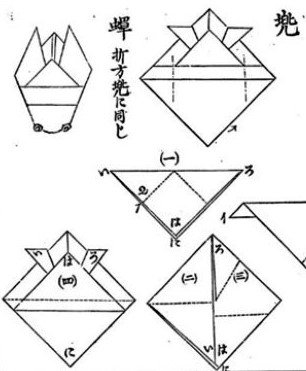
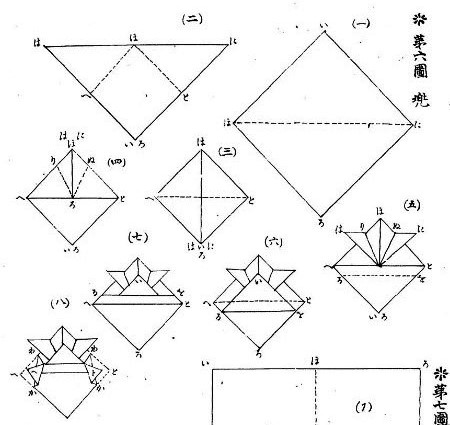
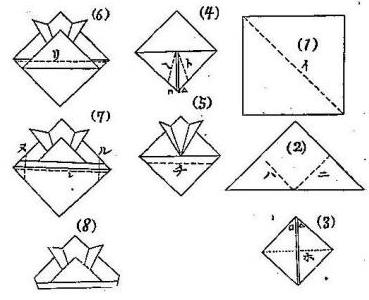
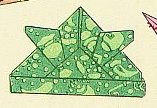
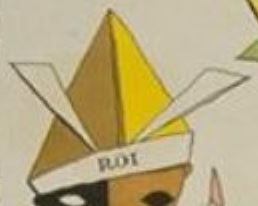
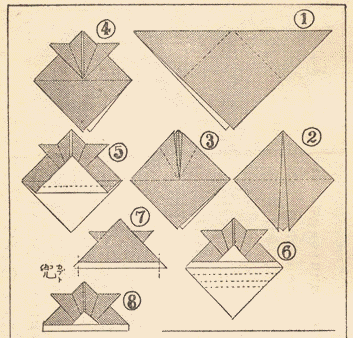
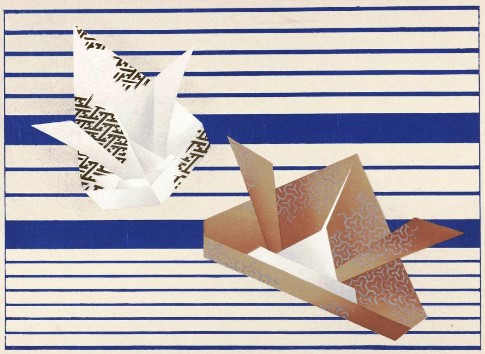
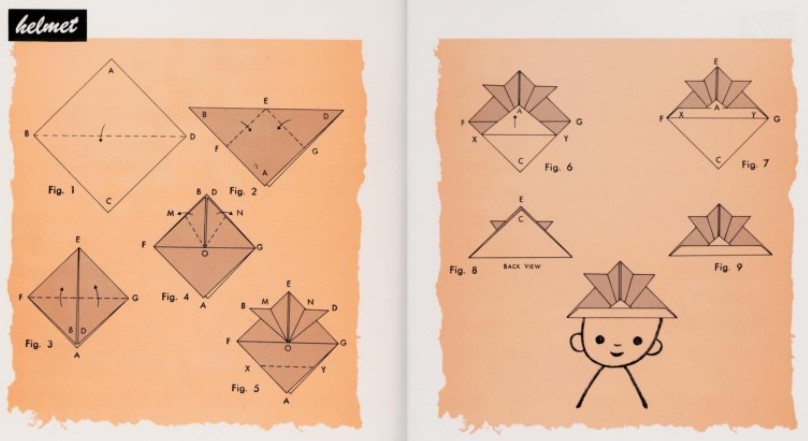
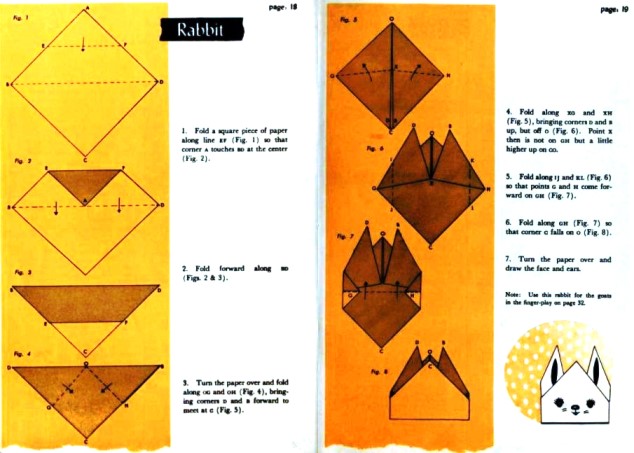
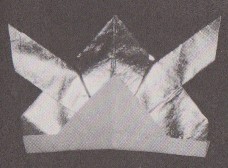
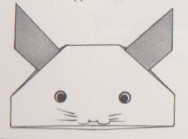
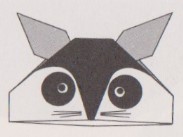
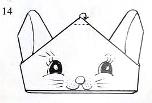

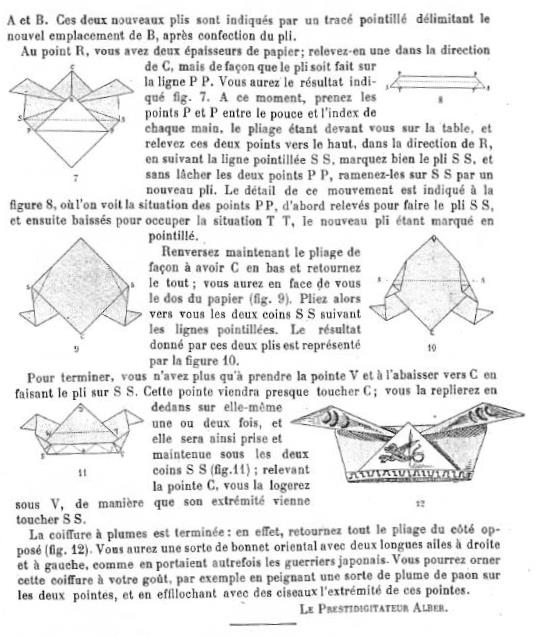
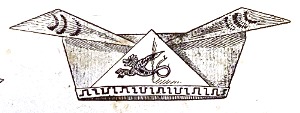

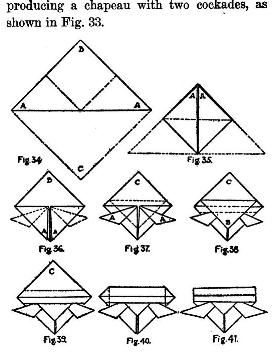
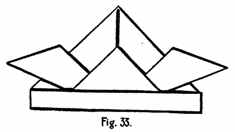
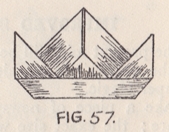
.jpg)
